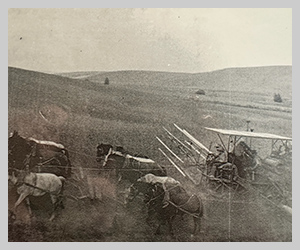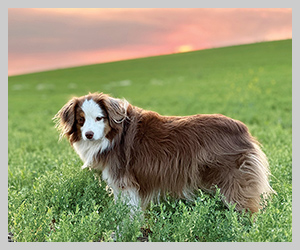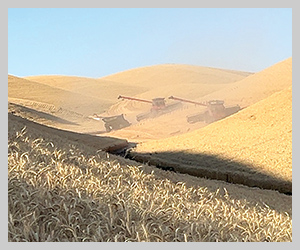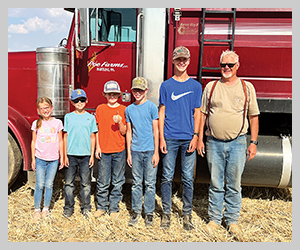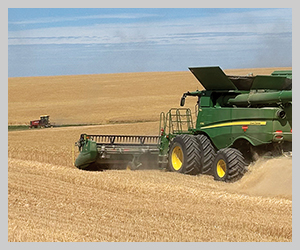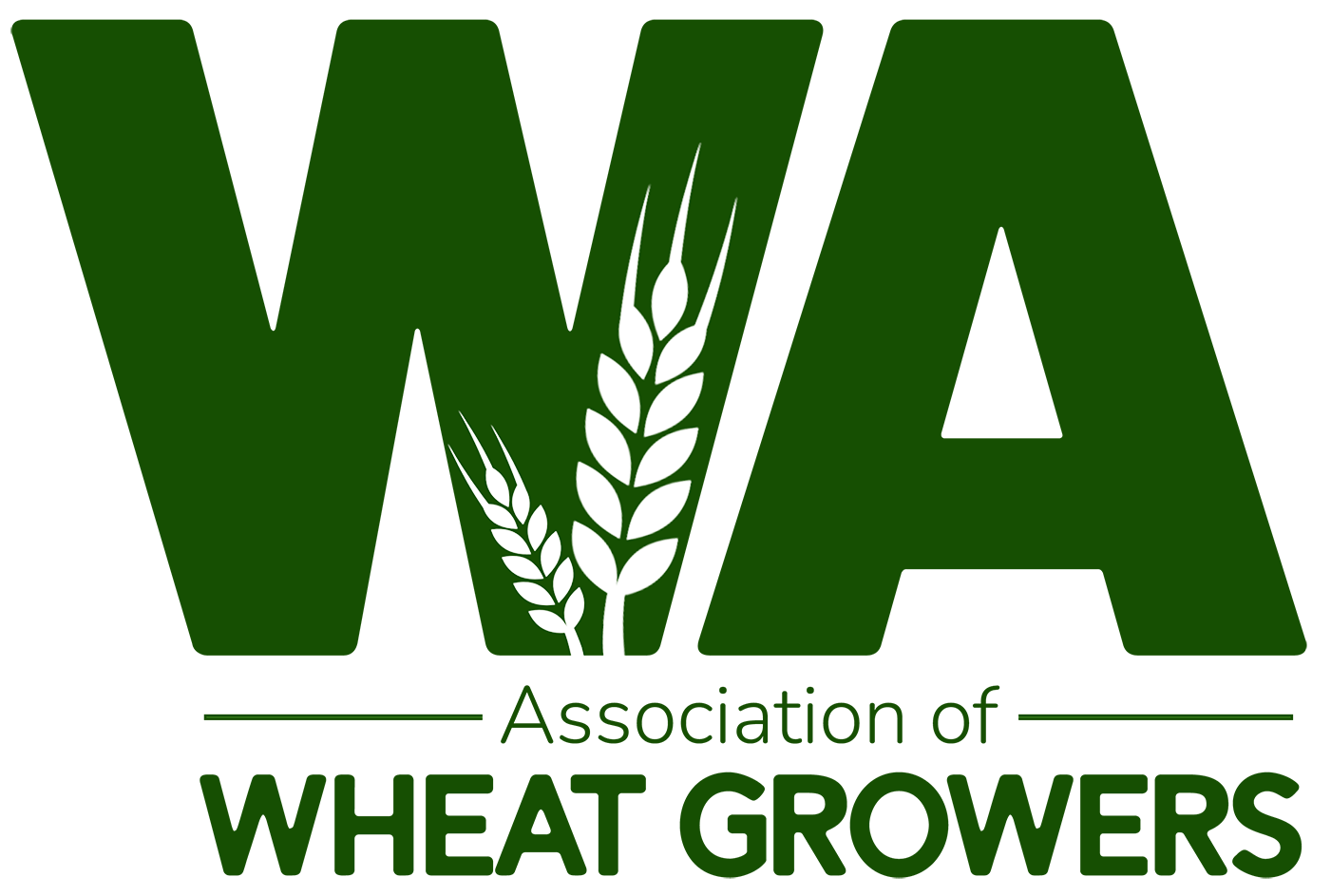Strategies for spraying AMMO session focuses on pesticides, weed management, EPA label information
2025March 2025
By Trista Crossley
Editor
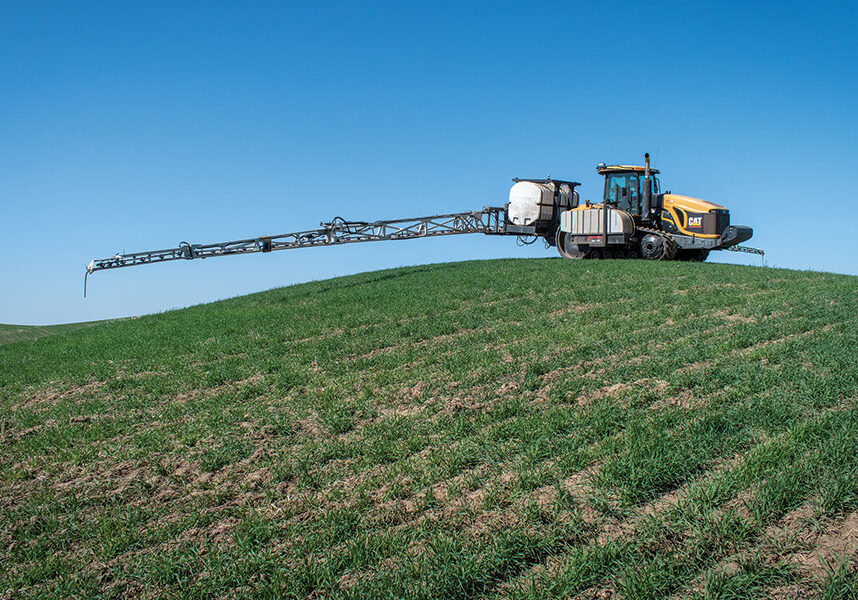
In the first Agricultural Marketing and Management session of 2025, some of the top researchers in the region explored the weeds and weed management practices Eastern Washington wheat growers are working with.
Drew Lyon, a professor and holder of the Endowed Chair Small Grains Extension and Research, Weed Science at Washington State University (WSU), tackled pesticide drift and herbicide efficacy and persistence; Henry Wetzel, WSU pesticide recertification safety educator, covered how the Endangered Species Act and the Environmental Protection Agency is affecting pesticide applications; and Ian Burke, a professor and the R.J. Cook Endowed Chair of Wheat Research at WSU, talked about managing weeds in wheat. Growers received three pesticide credits for attending the session.

Avoiding the drift
“There are two types of drift, spray particle and vapor. Both can cause injury in nearby susceptible things, and if it’s not going where you want it, you aren’t getting the control you need,” Lyon told growers at the beginning of his presentation. “That’s a problem for other people and you.”
Growers should pay attention to four things when dealing with pesticide drift:
- Wind direction. Know the location of anything sensitive around you and spray when there is a gentle, steady breeze that is blowing away from sensitive areas. Growers should also know the distance downwind of sensitive areas. As Lyon explained, if the distance downwind is doubled, the amount of drift decreases fivefold. For example, if the distance downwind increases from 100 to 200 feet, there’s only 20% as much drift at 200 feet as there is at 100 feet.
- Wind speed. There is almost a 700% increase in drift when wind speed doubles. Lyon doesn’t recommend spraying when the wind speed is more than 10 mph.
- Boom height. When the boom height increases, so does the amount of drift. “This is something you can control,” Lyon said.
- Spray droplet size. Growers can control this by the nozzles being used. Larger droplets are less likely to drift because they are heavier and slower to evaporate or volatilize.
Growers should also be aware of temperature inversions, which happens when a layer of cooler air gets trapped near the ground below a layer of warmer air. Pesticides can linger longer in the air and are more apt to drift. Inversions normally occur from just before sunset until just after sunrise when skies are clear to partly cloudy with light winds. Growers can recognize an inversion by watching to see if dust or smoke levels off instead of rising. Use of a smoke bomb or smoke generator is recommended to identify inversion conditions. AgWeatherNet is using temperature gauges installed at heights of 6 and 30 feet on some of their towers to identify the existence of temperature inversions and to predict temperature inversions for the next 24 hours.
“Drift will happen, but reduce it as much as possible,” Lyon said. “You can’t control the wind speed or direction, but you can control the droplet size to a large extent, so do the things you can do and try to manage around the things Mother Nature gives us. There is no substitute for common sense.”
Switching over to herbicide efficacy and persistence, Lyon told growers that there are a lot of factors that influence how persistent herbicides are in soil, but two big ones are the type of soil and soil pH. Clay particles, because of their larger surface area, provide more opportunity for binding or interaction with herbicides than sandy soils do. The amount of organic matter also plays a role.
Soils high in clay and/or organic matter have increased herbicide adsorption, decreased leaching, and decreased volatilization. Soils high in clay and/or organic matter generally have a greater potential for carryover and generally require higher use rates for activity. Medium and coarse-texture soils with less than 3% of organic matter are at lowest risk for herbicide carryover.
In soil, pH is often called the master variable because it influences so many things, including the biology of crops and microorganisms, the availability of nutrients, and, importantly, the ability to affect the charge properties of some herbicides.
According to Lyon, herbicides range from nonionic to ionic (charged). Nonionic herbicides are most likely to interact with organic matter, while ionic herbicides, which range from neutral to charged, are either repelled by or attracted to a given soil component. Most of the herbicides used by growers are weak acids. When soil pH is low, those herbicides aren’t greatly affected, but as the soil pH rises, they bind less, making them more likely to leach, be broken down by microbes in the soil, or be taken up by plant roots.
Some of the keys to avoiding herbicide persistence are:
- To know your soil pH, texture, organic matter content, and cation exchange capacity.
- Check the recrop statement on the pesticide label.
- Apply the correct rate for your soil type and weed problem.
- Consider herbicide combinations and avoid two or more herbicides with longer residual life.
- Plant tolerant rotational crops or varieties.
Bulletins Live! Two

Wetzel reviewed the Environmental Protection Agency’s (EPA) integration of the Endangered Species Act with pesticide registration through the agency’s use of bulletins, which became effective in late 2023. Bulletins are notifications for geographically specific information for threatened and endangered species habitat and will be found on pesticide labels. Bulletins must be obtained within six months of the planned pesticide application. Failure to follow bulletin instructions, which are an extension of the pesticide label, could result in hefty fines. In Washington state, bulletins are mostly focused on salmon.
“Your first line of defense is to look at the container label for endangered and threatened species protection requirements,” Wetzel said. “If it’s there, that means you need to go into the bulletin system. If your label doesn’t direct you to obtain a bulletin, no further bulletin action is required.”
To get a bulletin, go to epa.gov/endangered-species/bulletins-live-two-view-bulletins, enter the pesticide registration number and the location and date of the planned application. Wetzel recommended using GPS coordinates, rather than a street address, when possible. Growers can use Google Earth to get latitude and longitude.
If the location of the pesticide location comes up pink, that means it is in a Pesticide Use Limitation Area (PULA), and there are likely additional directions for pesticide use. In the upper right corner, growers can use the green “Printable Bulletin” link to find out the particular limitations for that pesticide in that location for that date. If your field is not located in a PULA, you will still get a green “Printable Bulletin” but most likely there will be no additional restrictions for the use of the pesticide. Growers are required to “obtain” a bulletin, but what that actually means is unclear.
“If you are outside a PULA, you don’t need to obtain a bulletin,” Wetzel explained. “Obtaining a bulletin means looking at it, not printing it or saving a pdf. You don’t need to keep it, but it’s a good idea to have it in case something goes wrong.”
EPA has begun using mitigation points to help limit herbicide spray drift and runoff. New federal registrations will require growers to have a certain number of mitigation points in order to use products with this language on the label, regardless of whether the application is in a PULA or not. To date, there is only one active ingredient, glufosinate-p-ammonium, (trade name, Liberty ULTRA), that contains the new mitigation information, and that active ingredient isn’t registered in Washington state yet.
Wetzel’s take-home advice for growers was:
- Read the pesticide label. Labels are changing.
- The container label is first line of defense. Look for the endangered and threatened species statement in directions for use.
- Online labels can be found through several online databases, such as PICOL or CDMS (Telus Agriculture).
- Application records. It doesn’t hurt to make a note that you checked the bulletin.
- Learn how to use a GPS program and map critical points on your farm.
- Do everything proactively to keep pesticides on your farm. Do the best you can with wind restrictions and knowing the weather within a reasonable amount of time of making applications.
- Do drift mitigation through spray droplet size or using pulse width modulation spraying technology.
- Do runoff/erosion mitigation (Natural Resources Conservation Service practices and soil conservation). Practices that you are already doing on your farm may count for the use of pesticides that have bulletins or label language requiring runoff/erosion mitigation. View EPA’s mitigation menu at epa.gov/pesticides/mitigation-menu for more information.
PNW weed management

Burke had some dire words for growers concerning the future of weed management in Pacific Northwest wheat.
“There are likely few, if any, products coming in the near future to match previous product introductions. We are at the end of the line for priority herbicide development,” he said, explaining that Pacific Northwest wheat has become somewhat of a minor market in the U.S., especially when compared to the Midwest’s corn and soybean market.
Currently, regional weed scientists are focusing on a variety of cultural and mechanical inputs for weed management, but all of them are incremental, time consuming, and potentially expensive, hazardous, or risky to implement. One promising direction is integrating weed biology in decision-making. Growers could make decisions on a per field basis if they know when weeds are emerging, and when they are most vulnerable. Establishing a good crop canopy is one of growers’ best weed management tools, behind crop rotations.
Another management tool gaining attention is harvest weed seed control — managing weed seeds in wheat chaff. Some of the options Burke talked about include a bale direct system, which is slow to operate and can be complicated. Chaff tramlining concentrates the chaff and weed seed in areas where it will be compacted by being repeatedly driven over. This is one of the cheaper options for farmers to implement. Impact mill systems, which send the chaff through an impact mill and shatters the weed seed, have been gaining traction in Eastern Washington. To make harvest weed seed control more effective, Burke suggested farmers plant the earliest maturing wheat varieties they can and then push the harvest date as early as possible when more of the weed seeds are still on the plants.
Burke also talked about using metribuzin, which is an important tool for effective control of grass weeds in wheat. However, because certain wheat varieties are less tolerant, growers have lowered application rates, making metribuzin much less effective. Burke discussed his work with the new wheat variety, Rydrich MZ. Burke recommended applying metribuzin according to label rates as early as possible in the spring to Rydrich MZ, avoiding preemergence or late postemergence. He said injury can still happen when applying metribuzin outside of early spring application timings, resulting in possible lower yields. He also cautioned growers that metribuzin carries rotational restrictions at higher rates, and farmers in annual crop areas should check that their rotation isn’t affected by the use of higher rates of metribuzin.
Burke briefly discussed Russian thistle and Palmer amaranth. He wrapped up his presentation by talking about the Pacific Northwest Herbicide Resistance Initiative, which is a coordinated, interdisciplinary, systems-based approach to managing herbicide resistance in weeds that is regional in scope and long-term in impact.




